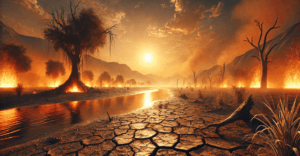India Records Earliest Heatwave and Warm Nights in 2025: A Growing Climate Concern
India recorded its earliest heatwave and warm nights in 2025, signaling a concerning rise in extreme temperatures. The country experienced its first-ever winter heatwave on February 25 in Goa and Maharashtra, making February 2025 the hottest in 125 years, according to the India Meteorological Department (IMD). Odisha and Jharkhand recorded their first warm nights on March 15, much earlier than in previous years. Between February 11 and 23, 31 states and union territories (UTs) saw higher-than-normal night temperatures, with 22 states experiencing temperatures 3°C to 5°C above normal, while some states, including Gujarat, Odisha, and Rajasthan, recorded temperatures exceeding 5.1°C above normal.
Heatwaves are also becoming more intense, with Odisha’s Boudh reaching 43.6°C on March 16. Scientists warn that prolonged exposure to extreme heat—both day and night—can increase mortality rates, worsen health conditions, and reduce agricultural productivity. A 1°C rise in night temperatures could reduce wheat yields by 6% and rice yields by up to 10%, while also affecting rice quality, making it less nutritious and palatable. The trend aligns with global climate change warnings from the IPCC’s Sixth Assessment Report. With heatwaves now starting as early as February, India faces a growing climate crisis that demands urgent action.

India Records Earliest Heatwave and Warm Nights in 2025: A Growing Climate Concern
India is experiencing a concerning shift in its climate patterns, with heatwaves arriving earlier and nighttime temperatures reaching unprecedented levels. The year 2025 marked a significant milestone, as the country recorded its earliest heatwave and unusually warm nights, highlighting an escalating climate crisis.
Record-Breaking Winter Heatwave
For the first time in recorded history, India endured a heatwave during winter. On February 25, 2025, Goa and Maharashtra experienced extreme temperatures typically associated with summer. According to the India Meteorological Department (IMD), February 2025 was the hottest February in 125 years, setting a new record. This early onset of a heatwave was unexpected, as such extreme winter temperatures had never been observed in India before.
Unusually Warm Nights Arrive Early
In addition to daytime heat, nighttime temperatures also remained abnormally high. Odisha and Jharkhand recorded their first warm nights on March 15, significantly earlier than in 2024, when Odisha experienced its first warm night on April 5 and Jharkhand on May 29. These early warm nights disrupt daily life and agriculture, as cooler temperatures at night are essential for human rest and crop recovery.
Regions Facing Rising Night Temperatures
Between February 11 and 23, 2025, 31 states and union territories reported nighttime temperatures above normal levels. In 22 of these regions, night temperatures were 3°C to 5°C higher than usual on multiple occasions. Some areas even experienced night temperatures exceeding 5.1°C above normal, including:
- Central India: Odisha and Gujarat
- East & Northeast: Assam, Bihar, Meghalaya, Tripura, and West Bengal
- Northwest: Jammu & Kashmir and Rajasthan
- Southern Peninsula: Karnataka
These persistently high nighttime temperatures reduce cooling relief, increasing health risks and agricultural losses.
Heatwaves Becoming More Intense
Heatwaves are not only arriving earlier but are also growing more severe. On March 15, 2025, Boudh in Odisha recorded India’s highest temperature of the year. The heatwave intensified further, with Boudh reaching 43.6°C on March 16, followed by Jharsuguda (42°C) and Bolangir (41.7°C). Such extreme temperatures in March—typically a transitional period before summer—underscore the changing climate patterns.
Impact on Health and Agriculture
Prolonged exposure to high temperatures, both during the day and night, poses serious health risks. Extreme heat increases the likelihood of heatstroke, sleep disturbances, and higher mortality rates, especially among vulnerable populations such as the elderly. Research published in The Lancet indicates that rising nighttime temperatures can disrupt sleep, leading to weakened immunity and increased health complications.
The agricultural sector is also under threat. Studies suggest that a 1°C increase in nighttime temperatures can reduce wheat yields by 6% and rice yields by 10%. Additionally, warmer nights impact rice quality, making grains chalky and less nutritious. Given India’s dependence on agriculture, such disruptions could contribute to food insecurity and economic challenges.
Climate Change as the Driving Force
These alarming trends align with global climate change projections. The IPCC’s Sixth Assessment Report warns that rising greenhouse gas emissions will lead to more frequent, intense, and prolonged heatwaves. Since 2022, Down to Earth (DTE), a leading science and environment publication, has tracked extreme weather events in India, documenting a steady rise in heat-related disasters.
The Need for Urgent Action
The accelerating climate crisis calls for immediate action. Heatwaves beginning as early as February, coupled with unusually high nighttime temperatures, highlight the urgency of implementing effective mitigation and adaptation strategies. Experts emphasize the need for improved heat action plans, expanded urban green spaces, and climate-resilient agricultural practices.
Without prompt intervention, the impacts of extreme heat will continue to escalate, affecting human health, agriculture, and the economy. The events of 2025 serve as a critical warning—climate change is no longer a future threat but a present reality that demands urgent attention.
You must be logged in to post a comment.